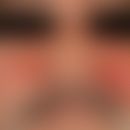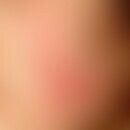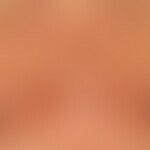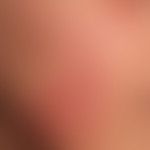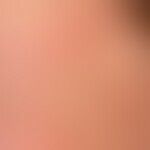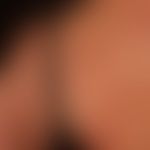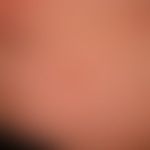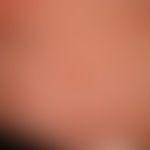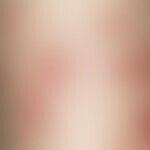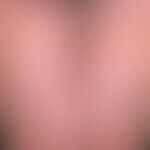Synonym(s)
HistoryThis section has been translated automatically.
Sweet 1964
DefinitionThis section has been translated automatically.
Rare, acute, high-fever systemic disease with disturbance of the general condition, arthralgias, neutrophilic leukocytosis and an exanthema consisting of disseminated, painful, succulent, papular or plaque-like elevations.
The Sweet syndrome is the prototypical representative of the so-called"neutrophilic dermatoses".
You might also be interested in
ClassificationThis section has been translated automatically.
Depending on the aetiology, 5 groups can be distinguished:
- Classical or idiopathic type, according to the initial description of Sweet
- Paraneoplastic type
- Infectious or autoimmune disease associated type
- drug-induced type
- Pregnancy-associated type.
EtiopathogenesisThis section has been translated automatically.
Cause often unexplained (idiopathic Sweet syndrome)
Infections: Interpretation as an infection - (about 60-80% of cases) allergic event. Infections are primarily infections of the upper respiratory tract or the intestines (salmonellosis, yersiniosis); non-tuberculous mycobacterioses (NTM), chronic inflammatory bowel diseases (IBD), especially Crohn's disease, can also be the cause.
The occurrence of Sweet syndrome after SARS-CoV-2 Oxford AstraZeneca vaccination is noteworthy (Žagar T et al. 2022).
Malignant underlying diseases (approx. 20%): Predominantly in hematological proliferative processes, especially in acute myeloid leukemia (AML), in myelodysplastic syndrome, here to be understood as progression of the disease (Vignon-Pennamen MD et al. 2017), less frequently in urogenital malignancies. Sweet syndrome often precedes the diagnosis of malignancy.
Drugs: known to be triggered by the following drugs: antibiotics (clindamycin, minocycline, cotrimoxazole), carbamazepine, granulocyte colony-stimulating factor (e.g. filgrastim), nitrofurantoin, retinoic acids, azathioprine, chloroquine, hydralazine, imatinib, bortezomib, contraceptives. The proportion of drug-induced sweet syndromes is estimated at around 5%. The skin changes occur about 7-8 days after the first intake of the drug (Walker DC et al. 1996).
Pathogenetically, an activation of neutrophil granulocytes by dermally deposited immune complexes with subsequent activation of neutrophil-associated mediators (granulocyte [PMN]-elastase, granulocyte colony-stimulating factor [G-CSF]) is discussed. Other cytokines involved: IL-1, IL-6, IL-8, interferon gamma.
Genetic Sweet syndromes: Majeed syndrome (OMIM: 609628) is characterized by an autosomal recessive mutation in the LPIN2 gene. This gene codes for the phosphatidate phosphatase LPIN2. Majeed syndrome is inconsistently associated with Sweet syndrome.
ManifestationThis section has been translated automatically.
LocalizationThis section has been translated automatically.
V.a. on face, neck, extensor sides of arms and legs, trunk.
Mucosal involvement is rare.
ClinicThis section has been translated automatically.
Usually occurs 3-7 days before the skin symptoms, flu-like prodromal stage with fatigue, arthralgia and high fever (fever may be absent).
- Integument: Sudden development of reddish-livid, succulent, pressure-dolent, infiltrated papules that confluent into nodules and plaques. The pronounced inflammatory edema initially gives the impression of blistering ("illusion of vesiculation"). In later stages, formation of confluent pustules. Central lightening and marginal progression lead to the formation of irregular, bizarrely shaped bright red plaques. No formation of ulcerations, no scarring of the skin lesions.
- An acral variant has been described.
- Extracutaneous manifestations: Polyarthritis (in approx. 50-60% of patients) with rapidly changing, very painful swelling of the large and medium-sized joints. Frequently fever (44%), myalgia, nephritis, hepatitis, conjunctivitis (approx. 30%) or iridocyclitis, inflammatory bowel disease, sterile osteomyelitis; rarely aseptic meningitis, rarely pancreatitis.
- Neutrophilic dermatosis of the back of the hand has been described as a (localized) minus variant of Sweet's syndrome.
LaboratoryThis section has been translated automatically.
Strongly accelerated ESR and elevated CRP (in approx. 80-90% of patients), leukocytosis (44%) with neutrophilia (63%) and left shift; lymphopenia. Pathological findings include: alkaline phosphatase (about 40-50%), transaminases (15-20%), anemia (30-50% in underlying malignancies), thrombocytopenia, proteinuria, HLA-Bw54 detection (20-30%). Positive detection of p- ANCA has been described.
HistologyThis section has been translated automatically.
Papillary edema to subepidermal blistering; spongiosis or subcorneal vesicles or pustules are possible but rare. The epidermis is usually unremarkable. Very dense infiltration of the upper and middle dermis, occasionally the subcutis, consisting of neutrophilic granulocytes (clonality of neutrophilic infiltrates has been described) without signs of leukocytoclastic vasculitis. Leukocytoclasia is mild or absent. Erythrocyte extravasations are seen. In later stages, the infiltrate changes to lymphocytes and histiocytes.
Histologic pattern: Superficial, diffuse, neutrophilic dermatitis.
Variant: Histiocytoid Sweet syndrome with diffuse infiltrate of immature neutrophilic mononuclear histiocytoid appearing granulocytes (promyelocytes: myeloperoxidase positive).
Variant: Subcutaneous Sweet syndrome with diffuse infiltrate of neutrophilic leukocytes in subcutaneous adipose tissue. No evidence of septal panniculitis (DD: erythema nodosum).
Notice. Clinical exclusion of chronic myeloid leukemia is required.
Schematizing the following algorithm can be established:
| Dense neutrophilic infiltrate in the dermis |
| capillaries excised |
| perivascular leukocytoclasia |
| Damage to endothelial cells |
| Fibrin in/in the area of vessel walls |
| perivascular extravasation of erythrocytes |
| Edema in the papillary dermis |
| Collagen degeneration |
| Variable number of eosinophils |
| No plasma cells or fibrosclerosis |
DiagnosisThis section has been translated automatically.
Main criteria
- Febrile exanthema with succulent papules, plaques and nodules
- Histology: neutrophilic dermatitis
Secondary criteria
- Prodromes
- Previous infection
- Fever >380C
- ESR > 20mm/h
- Blood count: neutrophilic leukocytosis with left shift
- Prompt response to glucocorticoids
Differential diagnosisThis section has been translated automatically.
Clinical:
- Erythema exsudativum multiforme: In the early phase of the disease, the clinical and morphological picture is similar. However, fever and neutrophilic leukocytosis are usually absent in erythema ex sudativum multiforme! In the full-blown erythema multiforme with formation of the EEM cocardia, the DD becomes clear.
- Polymorphous light dermatosis: Occurring after UV exposure (sun pattern!), no fever, no neutrophilic leukocytosis, severe pruritus.
- Acute urticaria: Clinical determination of wheal (prove volatility of efflorescences by marking). No fever! No neutrophilic leukocytosis.
- Urticarial vasculitis: Pronounced chronicity, sometimes lasting for years (atypical of Sweet's syndrome). Small-spotted, maculo-papular, pruritic or painful exanthema characterized by episodes of fever. Neutrophilic leukocytosis is possible. Frequent arthralgias and arthritides (also possible in Sweet syndrome). Frequent lymph node swelling. Possibly positive ANA and signs of systemic lupus erythematosus. Histologically, signs of vasculitis are diagnostic.
- Subacute cutaneous lupus erythematosus: Especially in highly acute course with disseminated plaques, a similar picture may develop (especially in erythema exsudativum multiforme-like lesions). Neutrophilic leukocytosis is always absent from the blood count. Histology and immunohistology are diagnostic.
- Varicella in adults: Attention should be paid to the typical distribution pattern of varicella (incl. capillitium, oral mucosa). This distribution is completely atypical for Sweet's syndrome. The prominent development of the vesicles or even blisters speaks against Sweet's syndrome (vesicles in Sweet's syndrome are multilocular within the lesions!). No neutrophilic leukocytosis!
- Drug exanthema (maculo-papular): No fever, no neutrophilic leukocytosis. No prominent feeling of illness. Association with altered or intercurrent drug administration can often be established.
- Bullous pemphigoid: In some cases, no formation of the clinically landmark blisters. This eliminates the leading clinical symptom of "bulging (firm) blister" and the clear clinical assignment to the blistering diseases. No fever, no neutrophilic leukocytosis. Serology, histology, and IF are conclusive.
Histology:
- Leukocytoclastic vasculitis: Usually excludes clinically. Histologic evidence of vasculitis (vessel wall swelling) with leukocytoclasia and perivascular nuclear dust is crucial in this case.
- Erythema elevatum diutinum: Rare disease! In early stage always signs of leukocytoclastic vasculitis with leukocytoclasia and nuclear dust and fibrin in the vessel walls. Epidermis and skin appendages remain uninvolved. Clinic lacks the acuity of Sweet's syndrome.
- Rheumatoid neutrophilic dermatitis: Dense, interstitial, dermal, neutrophilic infiltrate, no evidence of vasculitis; focal epitheliotropy with spongiotic vesiculation of pustular formation possible.
- Pyoderma gangraenosum: Ulceration and abscessation with dense diffuse granulocytic infiltrate.
- Urticaria: Only minor infiltrate; no significant involvement of neutrophilic granulocytes.
- Urticarial v asculitis: Variable intensity features of leukocytoclastic vasculitis. However, in many patients (especially when not relapsing), only predominantly superficial and profound perivascular round cell infiltrates are found, with eosinophilic granulocytes admixed at varying densities.
- Erysipelas: Only moderately marked infiltrate of neutrophilic granulocytes mainly in the upper and middle dermis.
- Eosinophilic cellulitis (Wells syndrome): Focally dense, perivascular and interstitial infiltrates, almost exclusively of eosinophilic granulocytes. Focal, polygonal, eosinophilic flame figures in the dermis.
External therapyThis section has been translated automatically.
Internal therapyThis section has been translated automatically.
If necessary, in the presence of an infection, treatment of the underlying disease with consistent systemic antibiotics.
Glucocorticoids: Very good response rate! Initial medium dosage, e.g. prednisone 1.0-1.5 mg/kg bw/day i.v. or p.o. for 4-6 weeks, then gradually reduced depending on response to therapy. Risk of recurrence if the dose falls below a critical threshold dose.
Alternative: acetylsalicylic acid and indomethacin in medium doses (indomethacin is particularly effective for the frequently occurring arthralgias).
Alternative: Colchicum 2-3 times/day 0.6 mg p.o. or DADPS 2 times/day 50 mg p.o. Our own experience with the latter therapies is not very positive. Thus, in our opinion, there are no effective alternatives to treatment with glucocorticoids.
Successful therapeutic approaches have been described with Ciclosporin A, Dapsone, IVIG and Spesolimab (anti-IL36).
Progression/forecastThis section has been translated automatically.
Favourable, even without therapy healing within weeks to months. Under therapy dramatic improvement. However, 50% of patients relapse after therapy-induced or spontaneous healing. In drug-induced sweet syndrome, the exanthema heals within 3-30 days after discontinuation of the drug in question. The fever subsides within 3-5 days.
Note(s)This section has been translated automatically.
Due to its histopathology characterized by neutrophil granulocytes, the Sweet Syndrome together with other dermatoses is classified as a so-called neutrophilic dermatosis.
LiteratureThis section has been translated automatically.
- Banse C et al (2015) Occurrence of Sweet syndrome under anti-TNF. Clin Rheumatol PubMed PMID: 26292633.
- Bayer-Garner IB et al (2003) Sweet syndrome in multiple myeloma: a series of six cases. J Cutan Pathol 30: 261-264.
- Brown AM et al (2002) Recurrent tenosynovitis in Sweet's syndrome. Rheumatology (Oxford) 41: 1067-1069
- Callen JP et al (2002) Neutrophilic dermatoses. Dermatol Clin 20: 409-419
- Clarke K et al (2018) Allergic and immunologic perspectives of inflammatory bowel disease.
- Clin Rev Allergy Immunol doi: 10.1007/s12016-018-86903
- Cohen PR, Kurzrock R (2002) Sweet's syndrome: a review of current treatment options. Am J Clin Dermatol 3: 117-131
- Cohen PR (2015) Proton pump inhibitor-induced Sweet's syndrome: report of acute febrile neutrophilic dermatosis in a woman with recurrent breast cancer. Dermatol Pract Concept 5:113-119
- Gambichler T (2000) Sweet's syndrome with eruption of pustulosis palmaris. J Eur Acad Dermatol Venereol 14: 327-329.
- Heymann WR (2015) BRAF inhibitor-induced neutrophilic dermatoses: a bitter-"sweet" scenario. Skinmed 13:132-134
- Kato T et al (2002) Acute febrile neutrophilic dermatosis (Sweet's syndrome) with nodular episcleritis and polyneuropathy. Int J Dermatol 41: 107-109
- Kemmett D, Hunter JAA (1990) Sweet's syndrome: A clinicopathological review of twenty-nine cases. J Am Acad Dermatol 23: 503-507.
- Khan Durani B et al (2002) Drug-induced Sweet's syndrome in acne caused by different tetracyclines: case report and review of the literature. Br J Dermatol 147: 558-562.
- Malone JC et al (2002) Vascular inflammation (vasculitis) in sweet syndrome: a clinicopathologic study of 28 biopsy specimens from 21 patients. Arch Dermatol 138: 345-349
- Metz R et al (1990) Acute febrile neutrophilic dermatosis (Sweet syndrome). Dermatol 41: 485-489
- Notfal A et al (2017) Sweet syndrome:revision of diagnostic criteria. J Dtsch Dermatol Ges 15: 1081-1089.
- Prasad PV et al (2002) Sweet's syndrome in an infant--report of a rare case. Int J Dermatol 41: 928-930.
- Ratzinger G et al (2015) The vasculitis wheel--an algorithmic approach to cutaneous vasculitides. JDDG 1092-1118
- Sprague J et al (2015) Cutaneous infection with Mycobacterium kansasii in a patient with myelodysplastic syndrome and Sweet syndrome. Cutis 96: E10-12
- Sweet RD (1964) An acute febrile neutrophilic dermatosis. Br J Dermatol 76: 349-356
- Vignon-Pennamen MD et al (2017) Histiocytoid Sweet syndrome and myelodysplastic syndrome. JAMA Dermatol 153:835-836.
- Wallach D et al (2015) Pyoderma gangrenosum and Sweet syndrome: the prototypic neutrophilic dermatoses. Br J Dermatol doi: 10.1111/bjd.13955.
- Walker DC et al (1996) Trimethoprim-sulfmethoxazole-associated acut febrile neutrophilic dermatosis: case report and review of drug iduced Sweet`s syndrome. J Am Acad Dermatol 34:918-923.
- Žagar T et al (2022) Bullous Sweet syndrome following SARS-CoV-2 Oxford AstraZeneca vaccine. Br J Dermatol 186:e110.
Incoming links (46)
Acute febrile neutrophilic dermatosis; Acute myeloid leukaemia and skin ; Adult-Onset Immunodeficiency Syndrome; Annular dermatoses; Aseptic abscesses syndrome; Betamethasone valerate emulsion hydrophilic 0,025/0,05 or 0,1 % (nrf 11.47.); Bowel-associated dermatosis-arthritis syndrome; Chronic recurrent annular neutrophilic dermatosis; Cotrimoxazole; Cutaneous extramedullary hematopoiesis ; ... Show allOutgoing links (45)
Acetylsalicylic acid; Anca; Betamethasone valerate emulsion hydrophilic 0,025/0,05 or 0,1 % (nrf 11.47.); Bubble; Bullous Pemphigoid ; Carbamazepine; Ciclosporin a; Colchicine; Cotrimoxazole; Crohn disease, skin alterations; ... Show allDisclaimer
Please ask your physician for a reliable diagnosis. This website is only meant as a reference.
